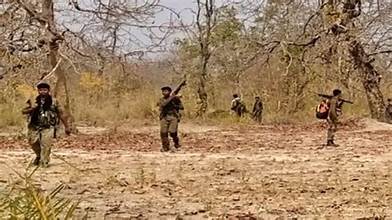As a major counter-insurgency operation enters its eighth day, the Chhattisgarh government remains resolute in its efforts to eradicate Naxalism from the state. This large-scale operation, focusing on the Chhattisgarh-Telangana border, aims to dismantle Maoist hideouts in the Karregutta and Durgamgutta hills, areas known for their difficult terrain and dense forests.
Chief Minister Vishnu Deo Sai stressed the importance of eliminating Naxalism as crucial to securing the region’s future. He made these remarks during a high-level meeting to assess the progress of the operation, which involves over 24,000 security personnel from various units, including the District Reserve Guard (DRG), Bastar Fighters, Special Task Force (STF), and the Central Reserve Police Force (CRPF). The operation is supported by aerial surveillance, with the use of helicopters and drones to monitor the area.
A Coordinated Effort to Clear Maoist Strongholds
The operation, launched on April 21, covers a vast area of approximately 800 sq km along the inter-state border, extending into Bijapur (Chhattisgarh) and Mulugu (Telangana) districts. This is one of the largest counter-insurgency actions in the Bastar region, a hotspot for Maoist activity. Intelligence sources suggest that over 500 Naxalites, including top leaders such as Hidma, Barse Deva, and Damodar, have gathered in the region, where they are using the dense forests and hills as a safe haven.
The Naxals belong to various Maoist factions, including the People’s Liberation Guerrilla Army (PLGA) Battalion No. 1, and the Telangana State Committee (TSC). They have been using the area to plan attacks on security forces and civilians.
Key Objective: Naxal-Free Chhattisgarh
Chief Minister Sai emphasized that the fight against Naxalism is not just a campaign but a critical mission to secure Bastar and Chhattisgarh’s future. Under the guidance of Union Home Minister Amit Shah, the state government is committed to making Chhattisgarh Naxal-free and development-focused.
In the meeting, Sai instructed security officials to strengthen coordination and intelligence sharing among various agencies. He stressed the need for proactive measures to address the evolving threat and ensure community safety.
Ongoing Challenges and Successes
The operation continues amidst harsh conditions, with security forces facing challenges from heatstroke, dehydration, and the rugged terrain. Despite these hardships, the morale of the troops remains high, and there have been significant gains. On April 24, security forces eliminated three female Naxalites and recovered a large cache of weapons, explosives, and communication equipment.
However, the operation is not without risks. Last week, a pressure IED planted by Naxalites exploded, injuring two security personnel. Nevertheless, there have been no fatalities among the security forces so far.
Recent Escalation in Naxal Encounters
The anti-Naxal efforts have been intensified since the BJP took power in Chhattisgarh in 2023, following a five-year tenure by the Congress. Since January 2024, security forces have neutralized more than 350 Naxalites in various encounters, many of which took place in the Bastar region. The March 29 encounter saw the death of 18 Naxalites, including 11 women.
This year alone, 144 Naxalites have been eliminated, with 128 of them killed in encounters across the Bastar Division, which includes Bijapur.
The Road Ahead: A Test of Endurance and Strategy
The ongoing operation, which officials have likened to a Test cricket match, is expected to be a long-term engagement. While immediate outcomes may not always be dramatic, the ultimate goal is to clear the region of Maoist influence and secure lasting peace. Authorities remain optimistic that with sustained effort, this mission will yield favorable results for both the security forces and the local population.





